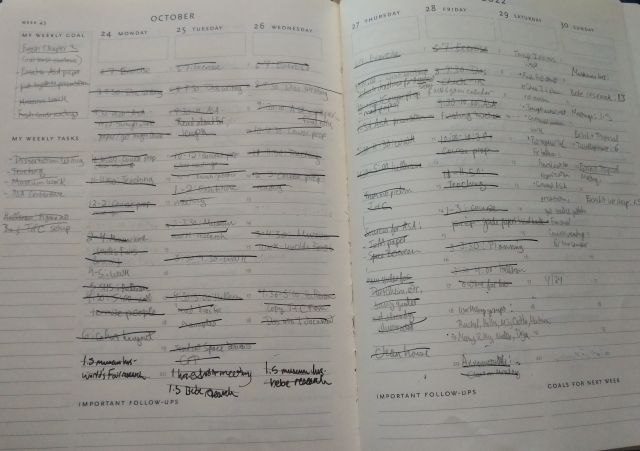Last month, I talked about the outlines I had created as part of the initial drafting process for Chapters 3 and 4. On October 17, the Monday after the mid-semester break, I started writing Chapter 3. On November 18, the Friday before Thanksgiving Break, I finished the initial draft of Chapter 4. In between those two breaks, I wrote about 85 pages worth of material, with a week’s break in between chapters to accommodate the annual ASA conference.

How did I manage to get all this writing done, especially given my other obligations this semester? Let’s take a closer look.
The first thing to keep in mind is that these drafts are preliminary. Their main objective is to take all the research I’ve been doing over the past few months, the hundreds of pages of notes I’ve taken on thousands of pages of documents, and distill that information into a text I can massage and recraft into something coherent. They’re not written to be pretty or even that readable: they’re written with the intention of getting rewritten. They’ll get rewritten at least once, probably more. This means that I’ve been writing quickly because the emphasis is on getting stuff down, not editing and revising. That comes later.
Second, of all the dissertation material I’ve been working on, these chapters are the ones with which I have the greatest familiarity. I’ve been working on the CACP off and on for a few years now. I already have a lot of research, and I’ve written plenty of material pertaining to community art centers, including conference papers, DH projects, book chapters, and more. Going into these two chapters then, I already had a pretty solid idea of the narrative I wanted to tell.
The plentitude of material also meant that I was able to get a head start on the writing. Rather than write both chapters entirely from scratch, as I’d done with chapters 1 and 2, I pasted several passages from these earlier writings and reworked them to suit the dissertation’s narrative. This meant that I went into each chapter with some parts already written in addition to a thorough outline complete with citations. In some ways, writing these chapters was more akin to an initial revision, with the disparate passages reworked to form one coherent narrative rather than starting with a blank page.
Finally, I made the time constraints of my schedule work in my favor. As I do every semester, I determined my dissertation schedule in advance, enabling me to begin the term with a clear research or writing plan in place. Since I knew I wouldn’t have a lot of time for research due to my teaching schedule, I prioritized writing, something I can do in shorter segments of time and with little to no travel. Using the calendar in my planner, I worked out a rough outline for the term, including the milestones I intended to reach. Once I had these goals in place, I set up a weekly schedule. Since I know I’m at my most productive in the morning, I made sure that I worked on my dissertation every day during these hours. During the week, I’d start work at 8:00 am, and usually be finished between 9:30 and 10:00, giving me time to prepare for class before heading to campus. It may not sound like a lot of time, but during that 1.5-hour block, I could usually write about 4-5 pages. By the end of the week, I’d have about 20-25 pages of material.



One thing that’s helped me throughout this drafting process is my previous curatorial experience. Thanks to the years I’ve spent curating in museums, I know how to manage large, long-term projects, something I’ve only continued to refine since being in grad school again. I assign myself deadlines to stay on track, work backward from those dates to determine how much time I have, and break down larger tasks into smaller ones that I can complete week by week. I use planners, calendars, and other tools to help me finish smaller goals while keeping the larger picture in mind. I periodically check in with myself to see if things are working, and make adjustments if they aren’t. This year, for instance, I switched from using a handheld chalkboard to a planner for scheduling because I needed more space to list my daily tasks and appointments while keeping larger project goals in view.
And finally, I have the assurance that comes with experience. Put simply, I’ve completed enough projects to know that as long as I work on something consistently, I’ll get it finished. Whether it’s an exhibition, a journal article, a DH project, or a knitted blanket, I know that I can get it done.
To be clear, these approaches don’t work for everybody, and I’m not claiming that the way I went about working up these chapters is how everyone should approach writing. For some people, it’s better to start from scratch than to work with extant texts because you’re not constrained by the ideas or language of the previous writing. Other people might be more productive with longer blocks of writing time, giving them the space to think and tinker with words. These methods worked for me though, which ultimately is what I care about. And honestly, given all my commitments between teaching, curating, and more, I’m proud of what I’ve managed to complete over the past several weeks.